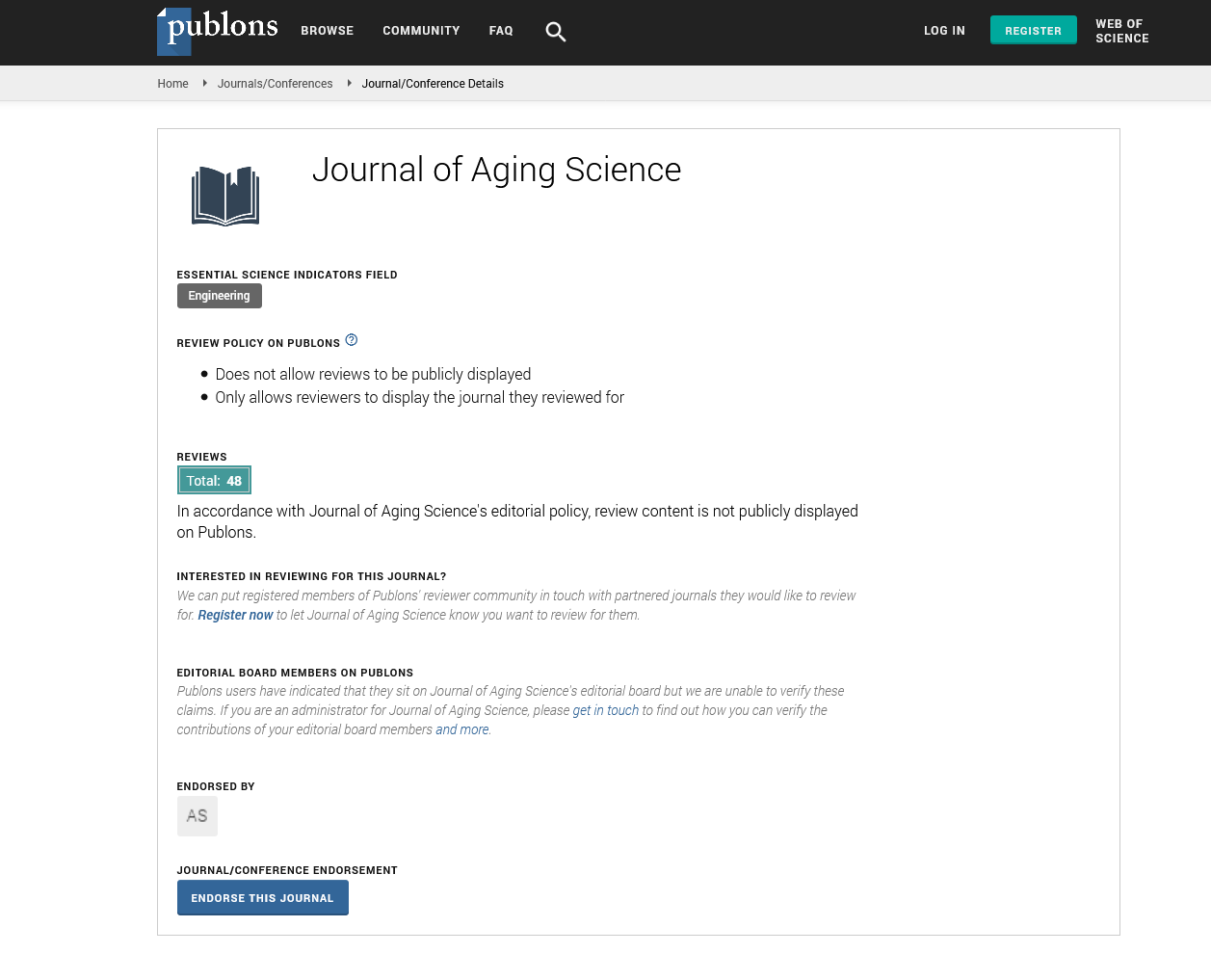Indexed In
- Open J Gate
- Academic Keys
- JournalTOCs
- ResearchBible
- RefSeek
- Hamdard University
- EBSCO A-Z
- OCLC- WorldCat
- Publons
- Geneva Foundation for Medical Education and Research
- Euro Pub
- Google Scholar
Useful Links
Share This Page
Journal Flyer

Open Access Journals
- Agri and Aquaculture
- Biochemistry
- Bioinformatics & Systems Biology
- Business & Management
- Chemistry
- Clinical Sciences
- Engineering
- Food & Nutrition
- General Science
- Genetics & Molecular Biology
- Immunology & Microbiology
- Medical Sciences
- Neuroscience & Psychology
- Nursing & Health Care
- Pharmaceutical Sciences
Commentary - (2025) Volume 13, Issue 3
Telomere Shortening and Longevity: Exploring the Molecular Limits of Cellular Lifespan
Bentick Nanas*Received: 30-Jun-2025, Manuscript No. JASC-25-29555; Editor assigned: 03-Jul-2025, Pre QC No. JASC-25-29555 (PQ); Reviewed: 17-Jul-2025, QC No. JASC-25-29555; Revised: 24-Jul-2025, Manuscript No. JASC-25-29555 (R); Published: 31-Jul-2025, DOI: 10.35248/2329-8847.25.13.417
Description
Telomeres are protective structures located at the ends of chromosomes. Composed of repetitive DNA sequences and associated proteins, telomeres safeguard genetic material during cell division by preventing chromosome ends from being mistaken as DNA breaks. Each time a cell divides, however, telomeres gradually shorten due to the inability of DNA polymerase to fully replicate the terminal sequences. This progressive shortening is widely regarded as a key feature of biological aging.
When telomeres reach a critically short length, cells can no longer divide and instead enter a state of senescence or undergo apoptosis. While this mechanism protects against uncontrolled cell proliferation and the development of cancer, it also reduces the regenerative capacity of tissues. Organs that rely heavily on continuous cell renewal, such as the skin, blood and immune system, are particularly affected. As telomeres shorten with age, these tissues exhibit reduced function, leading to visible and physiological signs of aging.
The rate of telomere shortening is influenced by both genetic and environmental factors. Inherited telomere length varies among individuals and mutations in telomere maintenance genes can lead to disorders characterized by premature aging. Lifestyle factors such as smoking, poor diet, chronic stress and lack of physical activity accelerate telomere attrition by increasing oxidative stress and inflammation. Conversely, healthier habits such as balanced nutrition, exercise and stress management have been linked to slower telomere shortening.
An important enzyme in telomere biology is telomerase, which adds DNA repeats to the ends of chromosomes, thereby extending telomere length. Telomerase activity is normally low or absent in most somatic cells but remains active in germ cells, stem cells and certain immune cells. This activity allows these cells to retain proliferative potential and maintain tissue function over time. However, in most body tissues, insufficient telomerase activity results in gradual telomere erosion with advancing age.
Research into telomere biology has revealed connections to multiple age-related conditions. Short telomeres have been associated with cardiovascular disease, diabetes, neurodegeneration and certain cancers. For example, individuals with shorter leukocyte telomeres are more likely to experience atherosclerosis, while those with longer telomeres may have improved cardiovascular resilience. Similarly, telomere length has been investigated as a biomarker of biological age, providing insight into an individual’s risk of age-associated illnesses independent of chronological age.
Therapeutic strategies targeting telomere biology are under active exploration. One approach involves telomerase activation. Studies in animal models suggest that controlled telomerase expression can extend lifespan and improve tissue function without necessarily increasing cancer risk, though balancing these effects remains a significant challenge. Certain compounds, such as TA-65 derived from astragalus root, are being investigated for their potential telomerase-activating effects in humans, though evidence remains limited.
Another promising area of research is gene therapy, in which telomerase-related genes are introduced into cells to restore telomere length. Early experiments in mice have shown that such interventions can improve organ function and extend lifespan. However, concerns remain regarding long-term safety, particularly with respect to the risk of promoting tumor growth.
Lifestyle-based interventions continue to show encouraging results. Studies indicate that individuals who adopt comprehensive lifestyle changes, including plant-based diets, regular exercise, mindfulness practices and social support, demonstrate slower telomere shortening. While these approaches may not directly lengthen telomeres, they appear to reduce the rate of erosion by lowering oxidative stress and systemic inflammation.
Telomere research also intersects with broader fields of aging science, such as cellular senescence and mitochondrial dysfunction. Shortened telomeres can trigger senescence, while oxidative stress from dysfunctional mitochondria accelerates telomere attrition. This interconnectedness underscores the importance of telomere biology as part of a larger network of aging mechanisms rather than as an isolated phenomenon.
As telomere science evolves, researchers are increasingly focused on distinguishing between correlation and causation. While short telomeres are strongly associated with aging and disease, it remains an open question whether they are a primary driver of these processes or simply a marker of cumulative cellular stress. Ongoing studies aim to clarify these relationships, which will shape the future of therapeutic approaches targeting telomere biology.
Conclusion
Telomere shortening represents a defining feature of cellular aging, with far-reaching implications for tissue function, disease risk and overall longevity. By limiting cell division, telomeres serve as guardians against uncontrolled proliferation but also contribute to the gradual decline in regenerative capacity. The interplay between telomere length, telomerase activity and environmental influences highlights the complexity of aging at the molecular level.
Although challenges remain, advances in telomere research point to exciting possibilities for promoting healthier aging. Interventions ranging from lifestyle modification to telomerasebased therapies and gene-editing approaches offer opportunities to slow telomere erosion and preserve tissue function. At the same time, ongoing work is needed to ensure that such interventions do not inadvertently increase cancer risk or disrupt other essential biological processes.
Citation: Nanas B (2025). Telomere Shortening and Longevity: Exploring the Molecular Limits of Cellular Lifespan. J Aging Sci. 13:417.
Copyright: © 2025 Nanas B. This is an open-access article distributed under the terms of the Creative Commons Attribution License, which permits unrestricted use, distribution and reproduction in any medium, provided the original author and source are credited.

